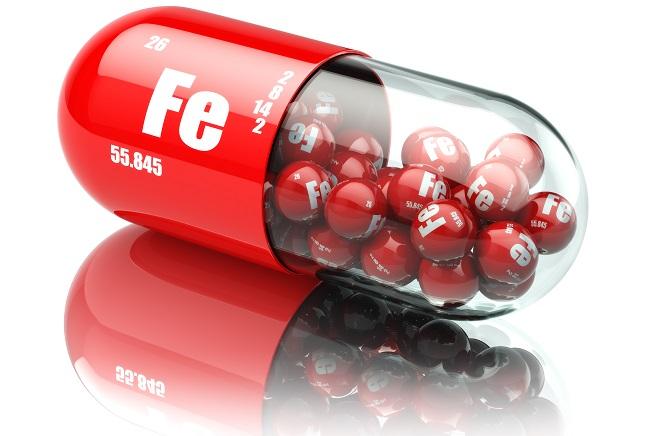Intravenous Iron, Not Oral, Improves Functional Capacity in HF Patients
The oral iron supplement failed to be absorbed, while the successful IV formulation is not without significant logistical and cost issues, say experts.

NEW ORLEANS, LA—Two new studies testing iron supplementation in patients with heart failure (HF) have yielded opposite findings, although experts say the differences are likely explained by how the iron was prescribed and how much was absorbed by patients in the trials.
In one study testing a convenient and easy-to-use oral iron supplement, investigators failed to show any improvement in functional capacity and other endpoints, while a more expensive intravenous iron complex tested in HF patients with and without anemia significantly improved peak oxygen uptake (VO2) when compared with standard of care.
The two studies—IRONOUT, which was sponsored by the National Heart, Lung, and Blood Institute, and EFFECT-HF with intravenous ferric carboxymaltose—were presented here today during the late-breaking clinical trial session at the American Heart Association Scientific Sessions 2016 in New Orleans, LA.
Stephan Anker, MD (Charité Medical School, Berlin, Germany), who was not involved in either trial, had a simple explanation for the discrepant results, namely that oral iron does not work in patients with HF because it’s not adequately absorbed. “If iron doesn’t get into the body, it’s difficult to imagine that it can exert any effect—the mechanistic issues are key,” he said.
Iron Deficiency a Focus in HF
Speaking with the media, Dirk van Veldhuisen, MD (University of Groningen, the Netherlands), the lead investigator of EFFECT-HF, explained that iron deficiency is present in approximately 50% of patients with chronic HF, affects functional capacity, and is an independent predictor of mortality.
Two previous studies, FAIR-HF and CONFIRM-HF, have shown that intravenous iron supplementation can improve 6-minute walk distance and quality of life and decrease HF hospitalizations. The issue, however, is that intravenous iron is expensive and poses logistical challenges for prescribers and patients, said Lewis.
In IRONOUT, the researchers led by Gregory Lewis, MD (Massachusetts General Hospital, Boston), sought to determine if an oral iron supplement was superior to placebo in improving exercise capacity in 225 patients with NYHA class II-IV symptoms and left ventricular ejection fraction ≤ 40%. When compared with placebo, however, there was no significant difference in the change in peak VO2 with the oral iron polysaccharide.
Given the negative findings, the researchers searched for potential mechanisms to explain the results. In doing so, they found that the repletion of iron stores as measured by ferritin levels and transferrin saturation both remained below the normal range and were no different than what was seen for placebo by the end of the study. In the 2009 FAIR-HF study, for example, ferritin concentrations were 20 times higher with the intravenous iron supplement and transferrin saturation was four times higher, said Lewis.
In addition to highlighting the mechanistic issues, Anker pointed out that iron absorption between patients is variable, meaning it’s possible that oral supplementation might have been underdosed at 150 mg. It’s also possible the patients simply didn’t take the supplement, he said, noting that oral iron is poorly tolerated and adherence can be quite bad.
Intravenous Iron, Better Results
In the EFFECT-HF study, 86 patients with NYHA class II/III symptoms received three intravenous injections of ferric carboxymaltose (day 0, week 6, and week 12) and were compared with 86 patients treated with standard of care. In contrast with IRONOUT, there was a significant difference in the change in peak VO2 in the two groups.
In the full analysis of 172 patients, there was no improvement in peak VO2 among the patients treated with iron while those who received standard of care had declining functional capacity over the 6-month trial (the between-group difference was statistically significant: P = 0.02). In the per-protocol analysis, which included 146 patients, there was a slight improvement in peak VO2 among the iron-treated patients (P = 0.01 for the between-group difference).
Speaking during the press conference, van Veldhuisen noted that various iron-related parameters, such as ferritin levels and transferrin saturation were also significantly improved with the intravenous supplement.
Clyde Yancy, MD (Northwestern University, Chicago, IL), said the two studies reflect an increased recognition of the importance of anemia in HF, and while the “target has shifted from anemia, per se, to iron deficiency,” there are still important issues to be resolved before iron’s use becomes commonplace in HF management. He noted that both trials were small and utilized a surrogate endpoint. Although VO2 is a validated endpoint in HF, there is still some degree of subjectivity surrounding the measurement, he said.
Regarding the potential benefit of administering ferric carboxymaltose, Yancy noted the cost is not insignificant. A clinical outcomes study testing ferric carboxymaltose, known as FAIR-HF2, is currently underway.
Michael O’Riordan is the Managing Editor for TCTMD. He completed his undergraduate degrees at Queen’s University in Kingston, ON, and…
Read Full BioSources
Lewis GD, et al. Oral iron repletion effects on oxygen uptake in heart failure (IRONOUT). Presented at: American Heart Association Scientific Sessions 2016. November 15, 2016. New Orleans, LA.
Van Veldhuisen DJ, Ponikowski P, Metra M, et al. Effect of ferric carboxymaltose on exercise capacity in patients with iron deficiency and chronic heart failure (EFFECT-HF). Presented at: American Heart Association Scientific Sessions 2016. November 15, 2016. New Orleans, LA.
Disclosures
- EFFECT-HF was sponsored by Vifor Pharma Ltd.
- Van Veldhuisen has received board membership fees and travel expenses from Vifor Pharma.
- IRONOUT was sponsored by the National Heart, Lung, and Blood Institute.


Comments